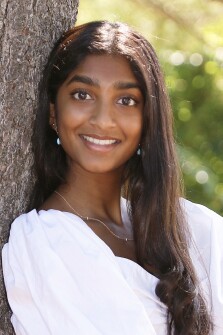Jobs in science, technology, engineering, and math are projected to grow by almost 11 percent by 2031âmuch faster than non-STEM occupations, according to the .
A majority of students are interested in these STEM careers, but some say they donât feel prepared to pursue jobs in those fields, according to a Walton Family Foundation survey of 1,002 students ages 12-18 conducted this summer.
Keerthi Vijay and Riya Shah, both of whom just graduated high school, are doing their part to help prepare younger students for those fields.
In 2020, the then-10th graders created , a free program where high school students help elementary students develop skills in the STEM fields as well as in art. Shah is the president of the organization, and Vijay the vice president.
âMaking STEM accessible for everyone, I think, is super important, especially because thereâs such an emphasis on it these days,â said Vijay, who will be attending New York Universityâs school of business in the fall.
In a Zoom interview with Education Week, Vijay discussed how the program works, why STEAM is important, and the organizationâs future.
This conversation has been edited for brevity and clarity.

Why did you decide to focus on STEAMâwith art includedâinstead of just STEM?
Oneâs ability to pursue STEM requires art and creativity, because STEM is all about problem-solving, which is all about being creative. So with STEAM, itâs very inclusive, itâs multidisciplinary. Fundamentally, our program doesnât run without that creativity aspect.
How did the program work during the early parts of the pandemic?
We would ship the [] kits that we use to peopleâs homes, and then we would pick a common time that works to run sessions over Zoom. The [high school] mentors would also have kits and build with them.
From there, we saw how much of a difference it made in these studentsâ lives, whereas theyâd do a full day of online school where there wasnât very much interaction and laughter. And then we were like, âoh, maybe weâll take this to the next level.â I reached out to a bunch of local organizations and we started doing in-person sessions [at different libraries in Fairfield County, Conn.]
How has it grown since then?
Our first year in 2020, we had taught about 50 students, and we had five full-time high school volunteers dedicated to two sessions every single week. Within the past two years since, weâve had over 600 students that weâve taught at various locations, and weâve had over 20 high school mentors.
The cool thing is itâs not just high school mentors from my high school. If we work with the library in a different town, we try to ask them to also see if they have students who would be interested, so we try to train them and get them involved and then try to create satellite branches. Our goal is to get every branch working almost independently, where the high schoolers run the sessions and they handle all the operations and then they can work with their [elementary] students.
It was definitely a collaborative effort. There were lots of people who pitched in. Our program wouldnât be where it is without our volunteers, without the students that keep coming back.
How did you come up with lesson plans for the sessions?
We thought about what we learned in school and how we can apply [those lessons] to everyday projects. What are some projects that are fun to build [and] very cool to look at, like towers, cars, bridges? And then from there, we thought about some very simple, easy, science concepts that we could apply to [whatever we were building].
We also like to get into a little bit of history, because learning nowadays is very multidisciplinary. For example, with towers, we talk about how over time building materials changed and thatâs allowed for taller, stronger buildings.
We created the lesson plans and guides for the different projects and also created videos on how to build them. So when we have students in other areas who want to start their own chapter, we have a little starter kit that has all of our lessons and video demos.
Whatâs next for Team STEAM?
We want to keep growing and expanding. Team STEAM has only gone so far within our area, and my goal is to get other students to start their own Team STEAM chapter. I want to keep doing outreach work. Weâre really working to start bringing Team STEAM into lower-income areas where they might not have robust library programs to afford the kits that we use. I want to start applying and receiving grants to fund the kits that we use.
And weâre applying for . And maybe being in college, I can start a chapter and get college students involved.








